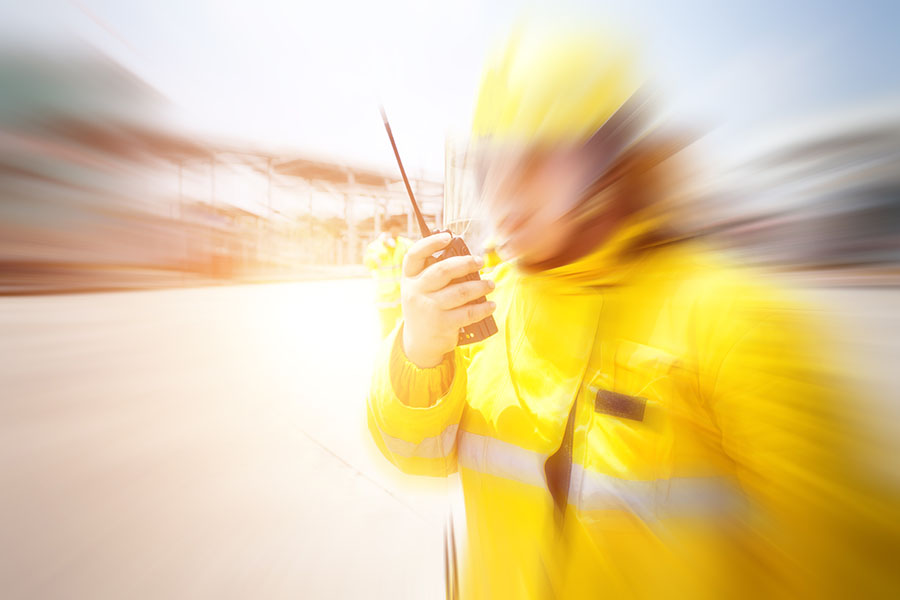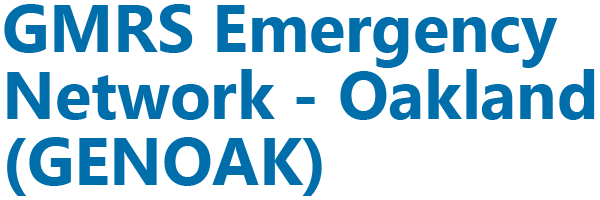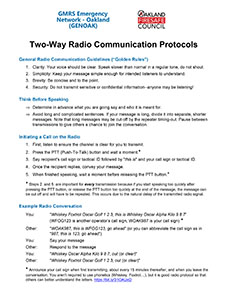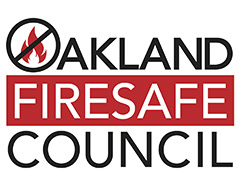Radio Communications
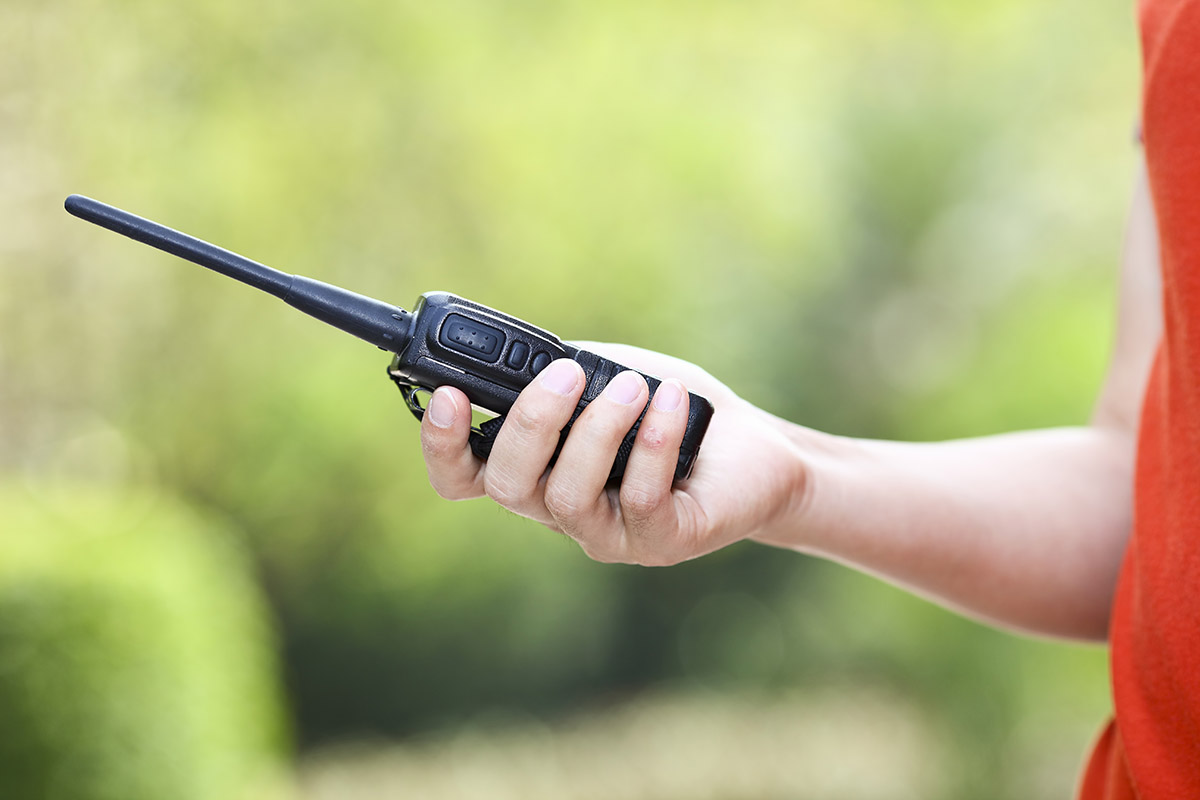
2-way Radio vs. a Phone
Talking over a 2-way radio is a bit different than over a phone. Phone calls typically involve known individuals speaking to each other, whereas with a radio you may be broadcasting out to many individuals who happen to be listening, and who may then want to reply. Because of this, using a 2-way radio requires having a unique identifier, known as a call sign, so that everyone knows who is speaking. And, since there may be many individuals wanting to speak, a procedure to manage this radio traffic is often used (called a “directed network”).
GMRS Licensing and Call Sign
To legally use a GMRS 2-way radio, you must first obtain a GMRS license from the Federal Communications Commission (FCC). The FCC will then provide you with your GMRS call sign. This is a relatively quick and easy process. It does NOT require an exam. A GMRS license costs $35 and is good for 10 years. The license holder’s immediate family may use the same license and call sign. You can apply by filling out paper forms, or you may apply online via the FCC Universal License System (ULS).
Click Here for Steps to Apply On-line for your GMRS License
Follow these to apply on-line for your GMRS license. It’s a few steps but not difficult. An excellent tutorial with screen shots can be found here.
Steps to apply online:
- Register for an FCC Registration Number (FRN), if you don’t already have one:
- Start here: http://wireless.fcc.gov/uls/
- Go to New User Registration and follow the instructions
- Write down your FRN and password
- Apply for a GMRS License:
- Go to the FCC ULS here: https://wireless2.fcc.gov/UlsEntry/licManager/login.jsp
- Log in with your FRN and password
- Click “Apply for a New License” at the top of the left-hand menu
- Select GMRS License (choose “ZA – General Mobile Radio (GMRS)” at the very bottom of the pull-down list)
- Fill out the application as instructed
- Verify your information and sign your application
- Pay the current license fee
- Get your assigned GMRS call sign:
- After your application has been granted (usually within a few business days), you can log back in to get your call sign and download a copy of your license
- Write down your call sign and tape it to your radio to help you remember, and learn how to say it using phonetics
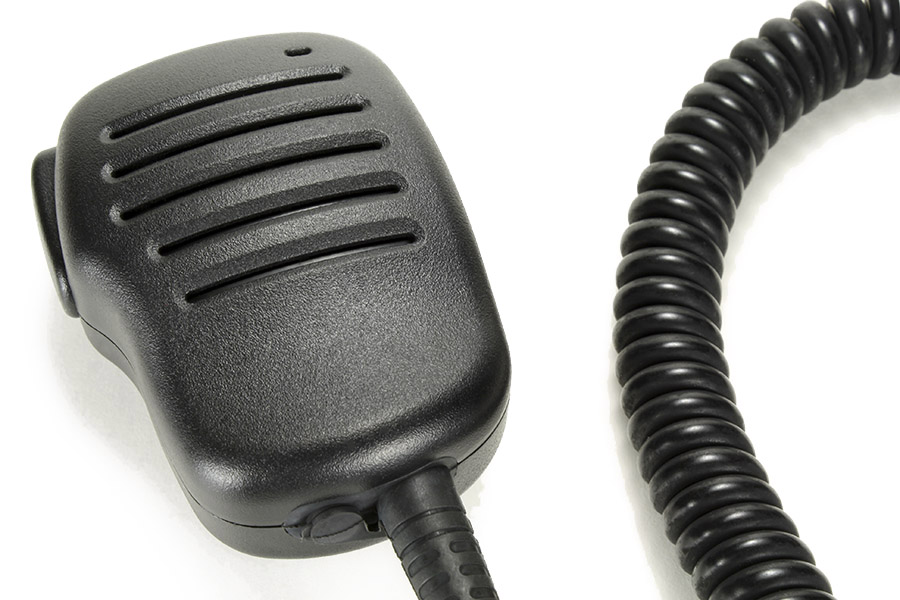
Directed Network and Net Control
A radio network (net) that follows standard operating rules is called a directed net. Nearly all directed nets have a similar basic structure. A Net Control Operator (NCO) initiates and leads the net, maintains order, directs the network activities, and then terminates net operations in an orderly way.
When practicing, for example during regular check-in nets, a Net Control Operator is usually determined in advance. However, in an emergency, typically the first person (operator) on the net becomes the NCO. If there are multiple operators on the net then they determine among those present who will be Net Control.
Net Control should request the following information from each operator during initial check-in:
- their GMRS call sign
- their tactical ID, which can be a community group/CERT Team name or personal first name
- their location; either a specific address, landmark, coordinates or a general Genasys Protect (Zonehaven) zone
- their specific function in their community group/CERT Team
- if they are also a licensed Amateur (Ham) operator, they can note that to be a potential Net Liaison Operator with the RACES net
- any emergency traffic (messages) they may have
Net Control responsibilities may be transferred as needed. To transfer, agree who will assume Net Control Operator duty and simply announce the change to the net. As soon as possible the list of operators checked in and their details along with any situation reports should be transferred to the new Net Control Operator.
What to do During and After an Emergency
If an emergency or disaster occurs, first check yourself and your family and make sure that everyone is safe. Then, help your neighbors as best as you can. Tips on responding to an emergency can be found here.
As soon as possible, turn on your GMRS radio and tune to the programmed GENOAK repeater channel. First listen to hear if anyone else is transmitting. If so, please wait for a break in the traffic to announce your GMRS call sign and join the net.
If you don’t hear anything, you can state your GMRS call sign and ask if there are any other GENOAK operators monitoring. If others are also monitoring you can share information as appropriate. You may then want to start a directed network and assign a Net Control Operator as noted above.
Radio Communication Protocols and Etiquette
If you are new to 2-way radios, or if you just need a refresher, review (and print) this PDF guide for information on two-way radio communication protocols that include the “Golden Rules,” initiating a call, an example radio conversation, emergency messages and some common radio terminology.
Some additional “netiquette” and best practices for operating a 2-way radio professionally and effectively include:
- Memorize your call sign and how to say it using phonetics. You should learn the entire phonetic alphabet. Labeling your radio with your call sign is a good idea.
- Identify with your call sign initially and at least every 15 minutes during a conversation, and finally at the end of your conversation (this is a legal requirement of your GMRS license). It is not necessary to say your call sign every time you speak. In a real emergency, you may also want to use a tactical ID (for example a community group/CERT Team name) at the beginning of each transmission.
- Talk in plain and clear speech. The international radio language is English. Please avoid 10-codes (e.g. “10-4”), Ham radio “Q codes”, “CB lingo” or other codes or abbreviations.
- Keep your transmissions brief and give others a chance to transmit. Especially during emergencies, leave gaps for someone with emergency traffic to jump in. Do not interrupt if you hear other people talking.
- Please keep all repeater access codes private and never mention them over-the-air.
- If you experience jamming or intentional interference, do not acknowledge that you are being affected in any way over-the-air. Simply conclude your session and contact us.
- Do not encourage or incite others to interfere with radio communications. This includes discussion of jamming or intentional interference events, making disparaging comments about other individuals or discussing any other operations that are not consistent with FCC rules. Please be courteous.
